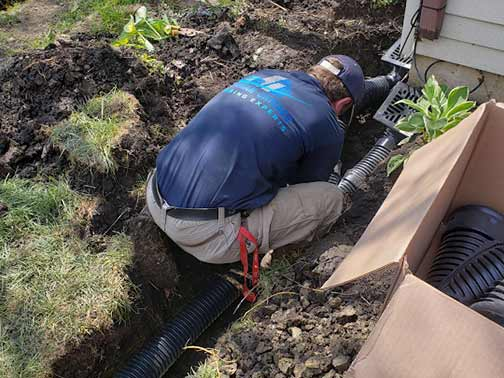
For lots of homeowners in Naperville (IL), water pooling around their homes is a huge problem. Water from melting snow and heavy rains collects around the house, making the yard ugly and hard to navigate. The resulting waterlogged soil hurts the home in many ways, says Louise Beck Management.
The poorly-drained soil around the property impairs plant growth, with a marked impact on the overall appeal of the home. This problem also encourages excess surface runoff that strips away topsoil, leaving plant roots exposed and creating uneven surfaces around the house.
Furthermore, with increased risk of flooding comes a greater possibility that the property will become a breeding ground for pests. The damp areas in the home may also encourage mold and mildew growth, worsening the health risks residents are exposed to.
But it doesn’t stop there; if water seeps into the building, it can cause massive structural damage. This is one of the leading causes of foundation failure in Naperville homes. The outcome of all these problems is that the house will be greatly devalued.
However, thankfully, there is an effective, affordable, and versatile way to deal with a poorly-drained yard.
How a French drain can prevent water damage in your Naperville, IL home
French drains are a deceptively simple but powerful solution for managing excess water around a home. It is nothing more than a gravel-filled trench with a perforated pipe. However, this unassuming system is what you need to tackle the drainage problems in your Naperville home.
In essence, a French drain is a below-ground trench used to divert subsurface water away from a specific area on a property. The system consists of a layer of water-permeable fabric, perforated plastic pipes, plus gravel and rocks of varying sizes, all contained within a trench.
How does a French drain work?
To install the French drain, a trench is dug, typically around the foundation or from the low-lying areas of the property where water usually collects. The route of the trench is plotted to terminate at a point where the water can safely be discharged.
To ensure the effectiveness of the drain, the natural slope of the land is taken into account. The slope of the drain is calculated, usually at a rate of 1 inch per 10 feet (or 1%). A trench with the following dimensions is dug: 18 – 24 inches deep and 12 inches wide.
The trench is then lined with geotextile fabric, a layer of gravel is placed at its bottom, and a perforated pipe is placed on top of the gravel layer. More gravel is added to the sides of the trench and over the pipe, before everything is draped with fabric to prevent clogging.
Subsequently, as water collects on the yard surface, it seeps into the soil, flowing through the gravel bed into the perforated pipes. The water is then channeled via the pipe, under the force of gravity, before being discharged at the preferred location on the property.
French drains are practical, affordable, highly efficient, and inconspicuous. If maintained properly, they can last a very long time. The benefits of French drains and their advantages over other drainage solutions are many.
- French drains are versatile: You can deploy them to tackle drainage problems inside or outside your house. If installed in the basement or crawl space, they protect the foundation. Exterior French drains may be installed near the foundation, along property lines, or even in gardens.
- Excellent water management: French drains will remove water even after it has infiltrated into the ground. This makes them a great choice for preventing standing water on your property and for erosion control on slopes and other vulnerable areas.
- French drains are aesthetically pleasing: Unlike most drainage systems, French drains do not alter the appearance of your home. They are concealed in the ground, allowing you to deal with your drainage issues while maintaining your home’s curb appeal.
- They require minimal maintenance: As long as you don’t crush them by driving a heavy vehicle over the site, a French drain will work for many years. You need to inspect it annually and hydro jet the drain to remove any silt inside the system.
- French drains are affordable: Because French drains use materials that are commonly available, the cost of installing them is minimal. French drains are also very durable, and they need very little maintenance to remain operational.
Does your Naperville, IL home need a French drain, and what do you need to know before installing one? If you are dealing with water pooling in your yard, basement flooding, or foundation issues in your home, you may need a French drain.
However, before you install a French drain in your home, consult an expert. That’s because, although they operate on the same principles, all French drains are not the same. A lot depends on the kind of environment where the drain will be installed.
—
If you are looking to have a French drain professionally installed on your Naperville property, give us a call today at 224-335-8479.

